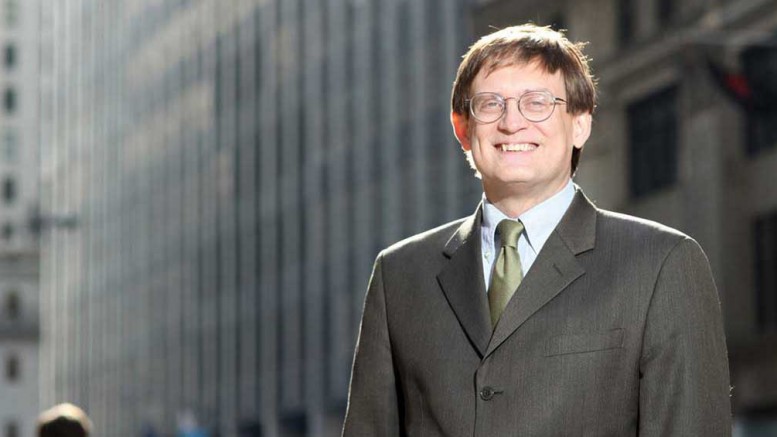Jeffrey Christian is the managing partner of CPM Group, a commodities research and management, consulting and financial advisory firm in New York. He founded the company in 1986, spinning off the Commodities Research Group from Goldman, Sachs & Co., and its commodities trading arm, J. Aron & Company. Christian is an expert on precious metals markets and took time out before an upcoming trip to China to speak with The Northern Miner about his outlook on gold, silver and platinum group metals.
The Northern Miner: We certainly are living in interesting times, with events like the Brexit vote and the election of Donald J. Trump as the next president of the United States. This could make your job forecasting metal prices all the more difficult.
Jeffrey M. Christian: The world just keeps giving us fascinating times. This one is right up there, that’s for sure.
TNM: What are your projections for gold over the short-term, medium-term and long-term, and how do you break down each period?
JMC: Our projections extend from one week to 10 years, and sometimes we have clients that want us to go further than 10 years. Our short-term view is one week to one year, our intermediate-term view is two to three years and our long-term view is three to 10 years, or beyond.
Looking at the gold market, year-to-date the price is up 7.5% on average. People got bullish earlier this year when prices rose off a cyclical low, but the reality is that it’s been a 7.5% increase in the average annual gold price, and our view is that next year it might rise 5%.
The average gold price this year is US$1,260 per oz., and we think it will average US$1,325 per oz. in 2017. We see a modest increase next year, and the price will probably rise more sharply beyond 2017.
We don’t know if it starts rising in 2018, or whether it could start rising in 2017, given the political events that have occurred.
Brexit was obviously a surprise, Trump’s election was a surprise and what he does as president is totally unclear. And then on Dec. 4 you’ve got the Italian referendum on constitutional changes, and if the Italians vote against that it could be short-term bearish for gold, long-term bullish for gold. [Editor’s note: Italians indeed voted heavily against proposed constitutional reforms, resulting in Italian Prime Minister Matteo Renzi tendering his resignation.]
There is a lot of political uncertainty. You probably won’t see these things being particularly problematic in 2017, but by 2018–2019 you probably may.
TNM: What’s your view on the election of Trump, and how it will play out for precious metals markets?
JMC: We’ve been writing for our clients and talking to our clients for a month now. People say, ‘Wow, what does this mean?’
One of the big points we keep making is that there are limitations to presidential power.
Frankly, Trump is very disconcerting to me in and of itself, because I try to be an honest and intelligent person and he is neither honest nor intelligent. It’s well known that he has a fascination for Hitler and Mussolini. It’s a matter of public record that he used to keep speeches by Hitler at his bedside and read them at night and if you look at his acceptance speech at the Republican National Convention in August, it was heavily influenced by a speech Hitler gave in 1932 called “Midnight over Germany,” in which Hitler said Germany had all these problems and only he could fix them. Trump almost plagiarized Hitler’s speech. So he has the kinds of fascist tendencies that concern people that like freedom.
But on the other hand, there are limits to presidential power. A lot of the things he says he would do, he simply cannot legally do. He’d have to suspend the Constitution to do a lot of the things he says he wants to do, and I don’t know that he has the political power to suspend the Constitution.
My view is that he will come in with a lot of bluster and showmanship, but at the end of the day he won’t be nearly as destructive to political and economic conditions as one might fear.
The one thing he can and will do is make a gigantic tax cut for corporations and wealthy people.
That money won’t be invested in real assets. It will go into the stock market either through corporate stock buybacks or individual investors. That will push stock prices higher, and when they continue to rise at an accelerated pace it will pull the dollar up, because you’ll find money around the world wanting to participate in the rising stock price.

Premier Gold Mines’ Mercedes gold-silver mine in northern Mexico. Credit: Premier Gold Mines.
Over the last four years, you’ve seen a situation where emerging economies have had severe capital constraints because money has gone out of those countries and into the United States.
This trend will probably accelerate, so the initial reaction to the U.S. presidential election will be higher U.S. stock prices and a higher U.S. dollar. In that kind of environment, you’ll probably see investors neglecting gold for a time.
But over time all of the U.S. government mismanagement will come home to roost and become more problematic later on. But later on is probably 2018, 2019.
So we think gold prices, on a nominal basis, will probably reach a record level by 2020 or 2025. But that’s a ways away.
TNM: What is your definition of a record gold price by 2020 or 2025?
JMC: We are looking for prices to move toward US$2,000 an ounce or so, on a nominal basis. Comments people make about prices rising to US$5,000 and higher are not based on economic or financial realities, and ignore the fundamental realities of both the gold market and the global financial system.
TNM: What’s your call on silver?
JMC: Silver, we’re a little more concerned about, because there’s more supply relative to demand. With silver you’re looking at a price that heavily depends on individual investors buying surplus amounts of metal. The silver market is perhaps a little bit more at risk than gold. So we see silver averaging US$17 per oz. this year and maybe rising to US$18.80 per oz. next year. One of the things you’re seeing is that there are more investors in more parts of the world who see gold as a safe haven and a way to diversify their portfolio. So investors’ first inclination is to buy gold, and their second inclination is to buy silver.
TNM: What about platinum group metals (PGMs)?
JMC: One of the things you’re seeing with PGMs is that they haven’t followed gold and silver as financial assets. They’ve behaved more like industrial commodities, which is sort of what they are. They don’t have 5,000 years of investor history.
We see platinum being flat next year — maybe 1% lower than it is this year — and palladium being stronger. The difference reflects the fact that palladium is used in catalytic converters for gasoline-powered cars more so than platinum. Platinum is used more in diesel cars than in gasoline-powered cars, and there is a shift underway in the world away from diesel to gasoline, and there’s a shift underway in the diesel catalytic converter market away from platinum to either palladium, or select catalyst reduction systems.
TNM: What are your specific target prices?
JMC: We’re looking at US$985 per oz. platinum next year — through October this year the price was US$1,007 per ounce. As for palladium, we think it will be US$666 per oz. next year compared to the year-to-date price of US$598 per ounce.So if you calculate the percentage changes, palladium could have the highest increase next year, and then silver and gold, and platinum might fall, actually.






Be the first to comment on "CPM’s Jeffrey Christian shares precious metal forecasts"